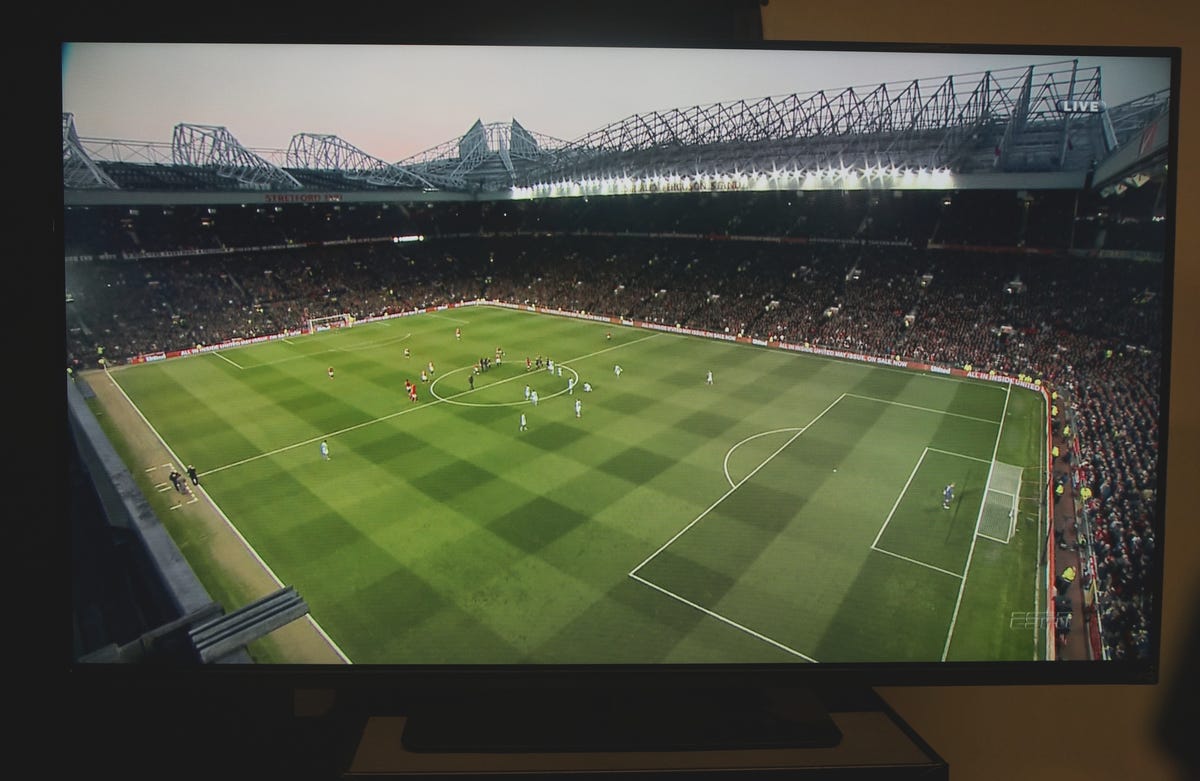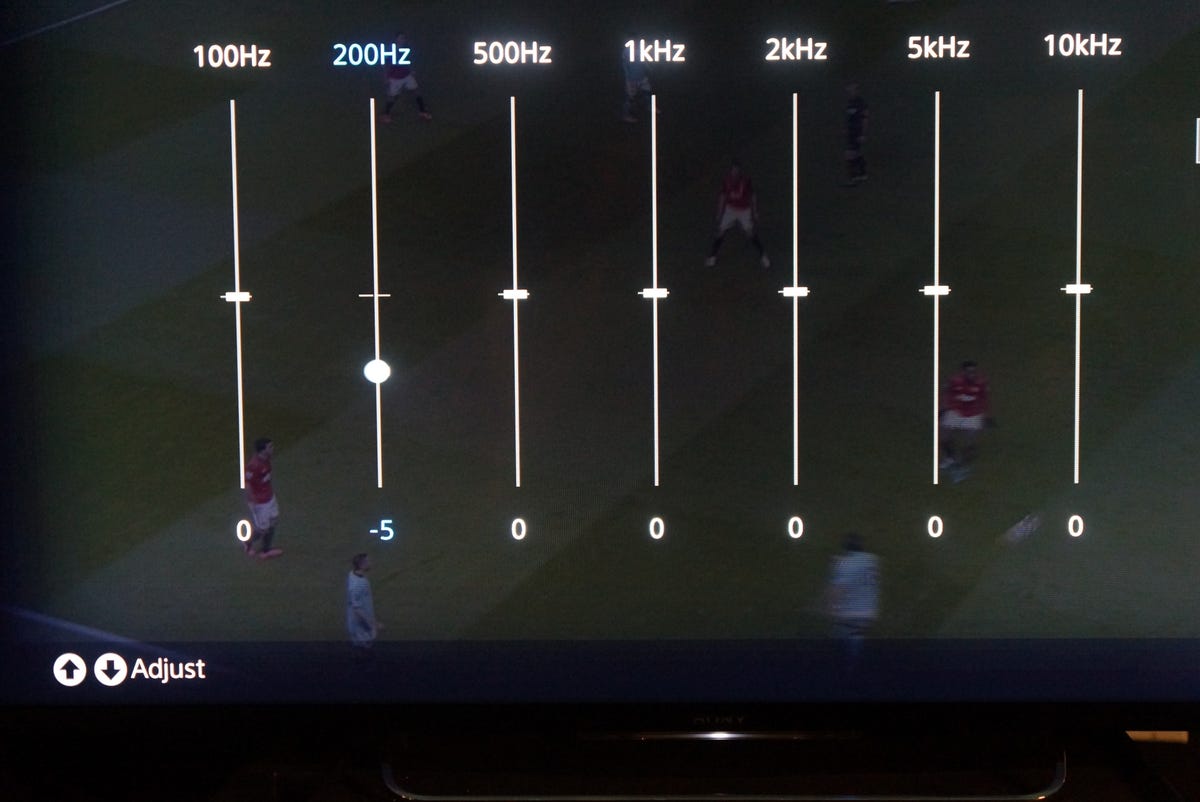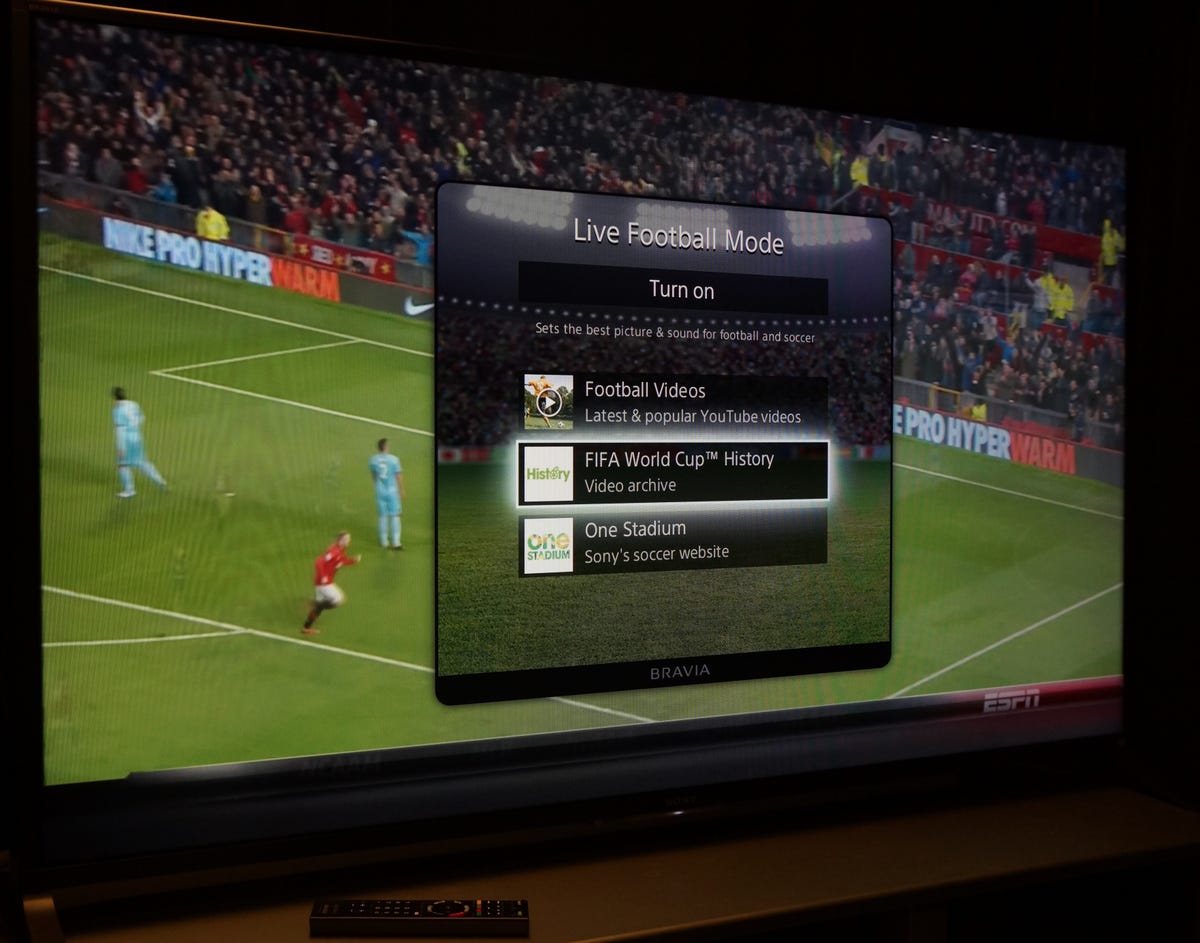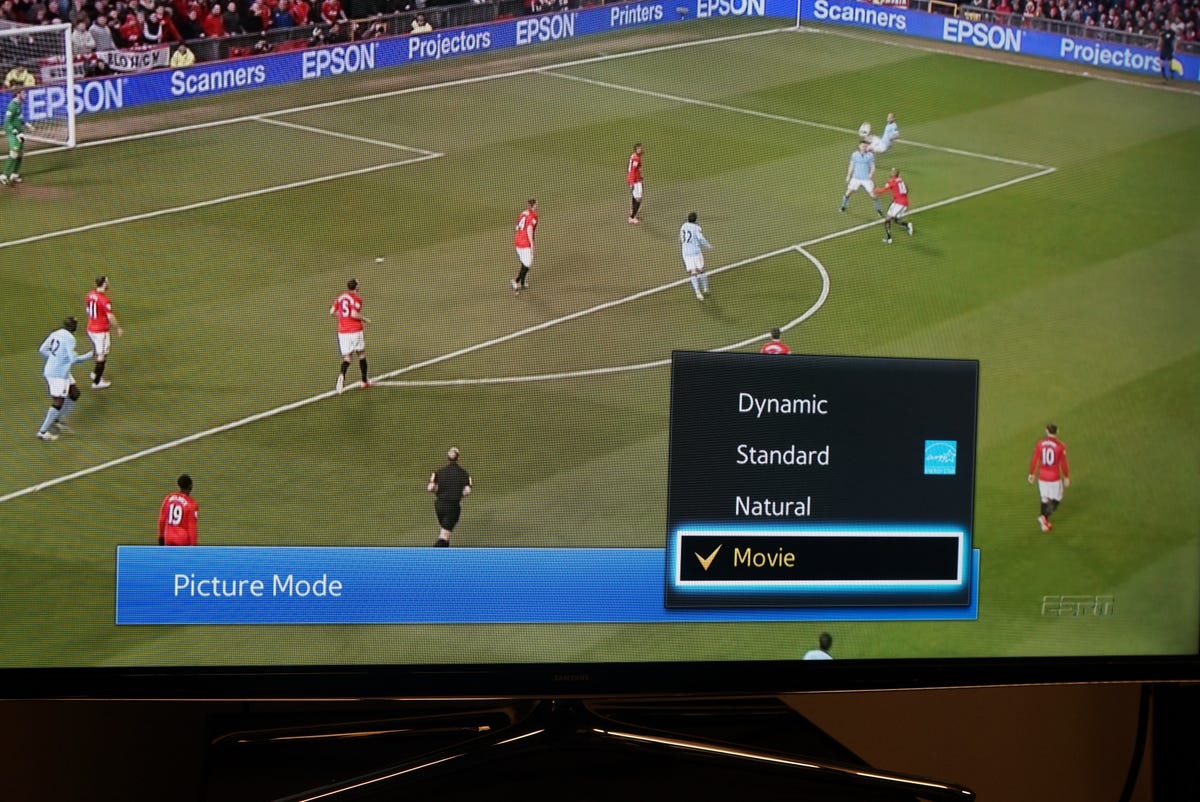
David Katzmaier/CNET
The world is now officially crazy for football (aka soccer) in the month-long, quadrennial frenzy of competition known as the FIFA World Cup. Sure, hundreds of thousands of people get to see the matches in person in Brazil, but hundreds of millions more will watch on TV all over the globe.
If you plan to be one of them, here are a few tips for getting your TV ready for the goal.
Go big
Soccer is presented primarily in a press box view, with a lot of the field visible at once, studded with all-too-tiny players. More so than most TV programs, it’s best suited to larger screens. You’ll get a better experience watching on as large a TV as you have available. And if possible, a projector.
If your TV is smaller, you can get a similar effect by sitting closer. High-def TVs often look great even from very close distances, so it might be worthwhile to move your seat closer to the TV for the match. That is, if doing so won’t obscure the screen for your friends.
Check the setup: HDMI, high-def, and 4K
The first thing you want to do is make sure the TV is set up correctly. If you have a high-definition cable or satellite box, make sure it’s connected via HDMI.
ESPN and parent company ABC are doing the broadcasts in the US, and they use the 720p high-definition resolution. Generally you’ll get the best results with those channels if you set your box to output 720p, not 1080i.
You’ll also want to make sure you’re tuned to the high-def versions of the broadcast. Most cable and satellite providers in the US carry both HD and standard-definition channels, and provided you have a compatible TV, HD will look much better.
For more details, check out How to set up an HDTV.
You may have heard that three matches, including the final, will also be produced in even higher-than-HD resolution, known as 4K. If you happen to be one of the very few people with a 4K TV, you might be wondering how you can watch them. Sorry, you can’t — at least not right now. The matches won’t be widely available to watch live in 4K. They might appear at a later date in archive form, however, and the Official FIFA 2014 World Cup film will be available in a 4K format, including 4K footage from those matches.


David Katzmaier/CNET
Sound matters
You should also get your audio set up correctly. If you’re using the TV speakers for audio, set your box to output stereo as opposed to 5.1 surround sound (Dolby Digital). But hopefully you’re using an external audio system or soundbar, which can not only deliver real or simulated surround sound (perfect for that great crowd noise) but also much better dialogue.
Speaking of dialogue and crowd noise, the 2010 World Cup was famously plagued (enhanced?) by the sound of the Vuvuzela trumpet, whose characteristic buzzing monotone dominated the broadcasts. It’s not expected to play as large a role in Brazil, but different instruments, like smaller horns or the official Caxirola rattle, might prove similarly annoying to TV watchers. Or maybe you’re the kind of person who prefers to listen to the crowd noise, instruments and all, and would rather turn down the announcers.
If that’s the case, try playing around with the sound controls. Many TVs and external sound systems have a multiband equalizer (above) that lets you decrease certain frequencies independently of others, quieting those sounds you don’t want to hear. If your equipment doesn’t have an equalizer, try experimenting with a sound mode or even the basic bass and treble controls.
And if you happen to be listening to the surround-sound broadcast on a surround system, you can turn down the center channel to minimize the dialogue from the announcers. Conversely, if you’d rather hear them over the crowd, turn down the other speakers (Left, Right and Surround) and turn up the center.


David Katzmaier/CNET
Picture settings: Bright ideas
At CNET, we calibrate the picture settings of every TV we review to get the best picture quality. If you happen to own one of the TVs we’ve reviewed, you can actually try our calibrated settings yourself. Search our picture settings forum for your TV to find out if we, or another reader, has posted settings for it.
Of course, our calibrations happen in a dark room, and your room might be brighter, especially if you’re watching during the daytime. If the picture seems too dim, try increasing the backlight control, which boosts the power of the illumination (typically LEDs) behind the LCD screen. If you have a plasma TV, try increasing Contrast or Cell Light instead. Also, be sure to disable any room lighting sensors, automatic brightness controls, or energy saver controls.
Maybe you’re even planning on taking the TV outside during the day. If that’s the case you’ll want the brightest picture possible. Try one of the Vivid or Dynamic picture modes, max out the backlight, and try to keep the TV out of direct sunlight (and the rain!). If you feel like buying a TV specifically for outdoor use, market leader SunBrite has you covered… for a price.
Not easy being green
During our calibrations we attempt to get the most accurate color possible. For soccer, the most common color you’ll see is the green of the field, and if it’s not accurate, it’s pretty easy to see. The human eye is very sensitive to green, and you can usually tell if grass looks too brownish or dull, or too yellowish or vibrant. When you’re watching football, you want as natural and accurate a color green as possible — the splendid pitch of the Estadio Do Maracana should not look like astroturf.


David Katzmaier/CNET
If you don’t have access to our picture settings, one of the best ways to assure accurate colors, including green, is to engage the Movie or Cinema preset (or THX, if your TV has it). Yes, it sounds counterintuitive, but Movie usually provides a more accurate color green than Sports or other picture modes. Those are often punched-up and oversaturated-looking, with greens that are much more intense than in real life. If you like the punchy look, on the other hand, maybe you’ll prefer one of those modes to a more-accurate one.
On some TVs, unfortunately, Movie will look too dark, even if you turn up the Backlight or Contrast all the way. If that’s the case, choose a different picture mode and look for a control called “color space” or something similar. There, you’ll want to choose the “HD” or “Auto” or “Rec 709” setting, not the “Native” setting. You may also be able to get the grass looking more natural by decreasing the color control.
The best time to make adjustments to the picture by eye is during the match itself — using another channel or program, even another grass-centric sporting event, won’t work as well. For more advice, check out How to Set Up a TV by Eye.
If you have a TV equipped with smoothing or dejudder (aka The Soap Opera Effect) you may want to do some experimenting with those settings as well. Look for a setting called Auto Motion Plus on Samsung, TruMotion on LG, Smooth Motion Effect on Vizio, and MotionFlow on Sony TVs. Football can sometimes benefit from the blur-reduction effects of those settings, but on the other hand, you may notice artifacts, for example trails behind fast-moving objects like a ball during a quick pass or goal kick. If you notice these effects, try turning the setting off completely.
Gooooooaaaaaaaal!
So, if you’ve decided you won’t be making the trek to Brazil or buying a new TV, at least you now have some ideas for getting your TV and home theater into prime match-time shape. Now feel free to redecorate your man cave in a nationalistic theme, invite your buddies over, and scream at the screen. Just skip the Vuvuzela, please.
This story was originally published in Spanish at our sister site, CNET en Espanol.




